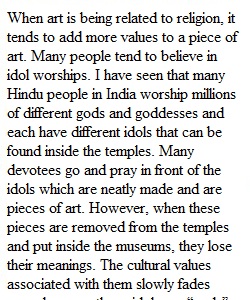


Q We have spent this lesson looking at approaches to sacred imagery in Judaism, Christianity, and Islam. When you visit just about any art museum today, you are bound to encounter paintings of Jesus, Mary, and the Saints; perhaps ceremonial vessels from a medieval synagogue; or elaborate tiles decorated with patterns or Islamic script from a mosque. These sacred artifacts have been divorced from their original setting and are now experienced more as "art" and not as functional objects. A majority of objects that we consider a part of the history of "art" today were originally not conceived as such. Also, with the development of modern aesthetics came the notion that art is defined as that which is, somehow, understood as separate from the realms of "usefulness," in the way that a hammer might be useful to build a house. Your question for this week is: What are your thoughts about this? What happens to a religious work (a piece conceived to be embedded in the everyday rituals of a religious practice) when it is removed from that context, placed into a museum, and understood as a "work of art"? What changes about the work? What stays the same (if anything)? To what extent does the context in which a work is placed determine its "meaning"? Does a medieval altarpiece in the Metropolitan Museum "mean" the same thing as when it was originally in a medieval church? What is the role of the viewer in this situation? How does that potentially alter the "meaning" of the situation? Is a museum a modern-day church? And what does all of this tell you about the nature of art and sacred imagery, and how artistic meaning is understood? Your post should be two to three (well-developed) paragraphs long.
View Related Questions